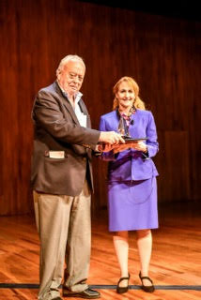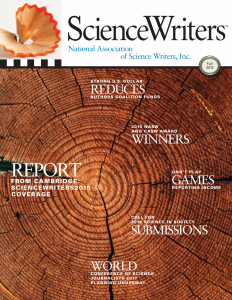CASW executive director emeritus Ben Patrusky presenting Jo Handelsman with an engraved crystal prism commemorating her Patrusky Lecture during this year’s New Horizons in Science briefing.
By Jeff Bessen
The federal government has assembled a fast-track committee to encourage research into microorganisms, reflecting the recognition of their increasingly important role in human health and the Earth’s climate.
Jo Handelsman, Ph.D., a Yale microbiologist and current associate director for science to the White House Office of Science and Technology Policy (OSTP), described the initiative during her Patrusky Lecture at this year’s New Horizons in Science briefing.“Microbes really run the world we live in; every aspect of it,” Handelsman said. “Microbes rule.”
Microbes or microorganisms (catch-all terms for bacteria, archaeabacteria, fungus, or virus) have been tied to climate change, human health, and mental illness. Some links have surprised Handelsman herself.
“People don’t know that when they crave chocolate, one of the reasons is that their microbes are addicted to chocolate,” she said. “They think that they’re making a human, conscious decision to eat chocolate, but it’s actually the microbes telling them what to do.”
Microbes live in complex communities, called microbiomes, virtually everywhere on Earth, from the thin upper atmosphere to deep-sea vents. They also grow in massive numbers in the human body, outnumbering human cells 10 to 1.

When Handelsman began her career, scientists were loath to acknowledge that microbiomes existed and factors both technological and psychological have hampered their study.
Before the 20th century, microbes conjured images in the public mind of bubonic plague and the Irish potato famine. While the discovery of penicillin hinted at the potential benefits of microorganisms, less than one percent of microbial species can be lab cultured. It took DNA sequencing technology to make scientists realize that millions of species of microbes surround us.
Also slowing the study of microbes has been lack of imagination together with a trend in science towards reductionism, wherein researchers preferred simpler theories and explanations. For example, stress or spicy foods were long considered causes of peptic ulcers. When two Australian scientists suggested the bacteria Helicobacter pylori caused ulcers, the duo was roundly ridiculed. To prove their theory, one scientist drank a culture of H. pylori, gave himself stomach ulcers, and then treated the symptoms with antibiotics. The pair won a Nobel Prize for their work.
Handelsman felt drawn to study microbes since grade school, and she cannot help but smile when talking about them. After graduate school, some treated her like “the village idiot” for continuing to study them. Early in her career, she viewed microorganisms as underdogs, and saw her role as a translator, giving a voice to the microscopic but mighty.
“They need more of an interpreter than other organisms or other fields of science where it’s obvious where the magic is,” she said. “There are very few things in biology that they don’t affect, one way or another, and that has to be interpreted because they’re invisible.”
Researchers and policy makers are now embracing her view. When OSTP formed the fast-track action committee in May, 14 federal agencies requested to join, a coalition Handelsman described as unusually broad.Handelsman predicts that many important roles for microbes remain undiscovered. For example, microbes can consume or produce greenhouse gases, and a strategy addressing climate change would be incomplete without considering them.
Matters of human health have also been shown to have microbial connections. For example, replacing the microbiome of a mouse with that of an obese human causes the mice to show symptoms of obesity. Similar links have been described for asthma, autism, and depression. Researchers are intrigued by the possibility of treating these diseases by focusing on the microbiome.
With the increased attention paid to microorganisms, Handelsman no longer sees them as underdogs in need of a champion.
“Now they speak for themselves,” she said.
“The Mighty Microbes: White House Initiative Recognizes the Huge Impact of Tiny Bugs,” posted Oct. 20, 2015, CASW website.
Jeff Bessen is a Ph.D. candidate at Harvard University studying genome editing and molecular biology.
(NASW members can read the rest of the Fall 2015 ScienceWriters by logging into the members area.) Free sample issue. How to join NASW.


